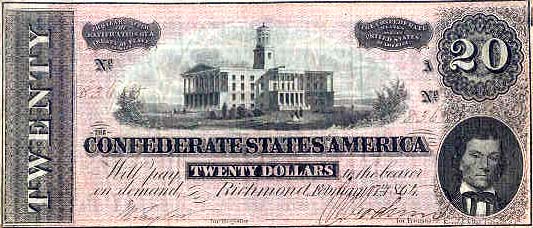by Mike Slate.
From 1862 through 1864 the Confederate States of America printed an estimated ten million twenty-dollar notes featuring an engraving of the Tennessee State Capitol. Today many of these notes survive in the hands of collectors and others, who may not be aware of the historical irony surrounding this currency.
Early Confederate twenty-dollar bills featured representations of a sailing vessel and various classical goddesses as well as a bust of CSA Vice President Alexander H. Stephens. Pursuant to the Confederate Congressional Act of October 13, 1862, the first Tennessee State Capitol notes were soon printed . . . and there the irony begins. This note’s design shows miniscule yet visibly genteel folk strolling the Capitol grounds. However, months earlier, on February 25, 1862, Nashville Mayor R. B. Cheatham had surrendered the panicked city of Nashville to Union General Don Carlos Buell. Long before October 13 Confederate currency was worthless in Nashville.
With the Federal occupation of Nashville came the immediate securing of the statehouse and the hoisting of William Driver‘s famous flag, “Old Glory,” on Capitol Hill. To be sure, no Southerners lolled around the Capitol grounds after February 25. Iron-fisted military governor Andrew Johnson arrived in Nashville on March 12. By the time of the October 13 Act, the Capitol was undergoing heavy fortification as Fort Andrew Johnson.

It seems likely that, although the “Tennessee Capitol” note was issued twice more (following the Act of March 23, 1863, and the Act of February 17, 1864), many Nashvillians did not see this currency until years after its initial printing. The bill was engraved – and presumably printed – by the firm of Keatinge & Ball in Columbia, South Carolina, a city significantly distant from occupied Nashville. There may be more of these notes in Nashville today than there ever were during the Civil War.
The Tennessee Capitol vignette was engraved probably by Edward Keatinge, who had worked for the American Bank Note Company in New York City. Recruited by the Confederacy for its treasury department, Keatinge teamed with Virginian Thomas A. Ball to form Keatinge & Ball, Bank Note Engravers, in Richmond. Soon the firm removed to Columbia, South Carolina, a strategically safer location. There they produced Confederate currency using equipment and supplies smuggled from Europe through the Federal blockade. General Sherman destroyed the firm’s facilities in February 1865.
Only two other Southern capitol buildings adorned Confederate currency: those of Columbia, South Carolina, and Richmond, Virginia. Despite the irony of its issuance, the Tennessee Capitol twenty-dollar bill is nevertheless a tribute to an architectural gem, the timeless work of Philadelphia architect William Strickland.

gibbsusa2@gmail.com my uncle was a crain operator and tore drown the Maxwell hotel could you text me the location where the debris my name is steve gibbs 615 812 56886 like this site inn nashville.
LikeLike
Sorry, Steve, I have no idea what happened to the debris. The hotel burned in 1958, so I expect anything that remained disappeared long ago. Can any NHN readers answer this question?
LikeLike